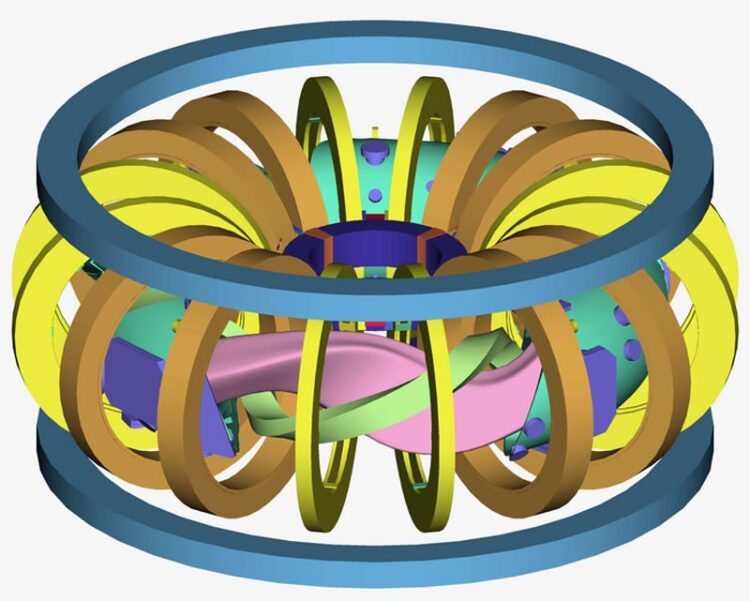Cooking up plasmas with microwaves

Structure of Heliotron J device
Credit: KyotoU/Heliotron J group
Plasma physicists from Ukraine, Germany and Japan collaborate to spark fusion power.
Lead author Yurii Victorovich Kovtun, despite being forced to evacuate the Kharkiv Institute of Physics and Technology amid the current Russia-Ukraine war, has continued to work with Kyoto University to create stable plasmas using microwaves.
Getting plasma just right is one of the hurdles to harnessing the massive amounts of energy promised by nuclear fusion.
Plasmas — soups of ions and electrons — must be held at the right density, temperature, and duration for atomic nuclei to fuse together to achieve the desired release of energy.
One recipe involves the use of large, donut-shaped devices with powerful magnets that contain a plasma while carefully aligned microwave generators heat the atomic mixture.
Now, the Institute of Advanced Energy at Kyoto University, together with the Kharkiv Institute and the Max Planck Institute for Plasma Physics have collaborated to create plasmas with fusion-suitable densities, using microwave power with low frequency.
The research team has identified three important steps in the plasma production: lightning-like gas breakdown, preliminary plasma production, and steady-state plasma. The study is being conducted using Heliotron J, the latest iteration of experimental fusion plasma devices at the Institute of Advanced Energy, located on KyotoU’s Uji campus in south Kyoto.
“Initially, we did not expect these phenomena in Heliotron J but were surprised to find that plasmas were forming without cyclotron resonance,” group leader Kazunobu Nagasaki explains.
Building on decades of experience, Nagasaki’s team is exploring the fusion plasma discharges in Heliotron J.
The team injected intense bursts of 2.45-GHz microwave power into a feed gas. Microwave ovens in the home operate at this same frequency but Heliotron J is around 10 times more powerful and concentrated over a few gas atoms.
“Unexpectedly, we found that blasting the microwaves without alignment of Heliotron J’s magnetic field created a discharge that ripped electrons from their atoms and produced an especially dense plasma,” marvels Nagasaki.
“We are extremely grateful that our colleague could continue supporting the study, despite the war in Ukraine. Our findings about this method to generate plasmas using microwave discharge may simplify fusion research in the future.”
The paper “Non-Resonant Microwave Discharge Start-Up in Heliotron J” was published on 23rd February 2023 in the journal Problems of Atomic Science and Technology: Plasma Physics at doi: 10.46813/2023-143-003
About Kyoto University
Kyoto University is one of Japan and Asia’s premier research institutions, founded in 1897 and responsible for producing numerous Nobel laureates and winners of other prestigious international prizes. A broad curriculum across the arts and sciences at both undergraduate and graduate levels is complemented by numerous research centers, as well as facilities and offices around Japan and the world. For more information please see: http://www.kyoto-u.ac.jp/en
Credit: Nano Pico Science (www.nano-pico-science.com)
Journal: Problems of Atomic Science and Technology
DOI: 10.46813/2023-143-003
Method of Research: Experimental study
Subject of Research: Not applicable
Article Title: Non-Resonant Microwave Discharge Start-Up in Heliotron J
Article Publication Date: 23-Feb-2023
Media Contact
Jake G. Tobiyama
Kyoto University
tobiyama.gakuji.6y@kyoto-u.ac.jp
All latest news from the category: Physics and Astronomy
This area deals with the fundamental laws and building blocks of nature and how they interact, the properties and the behavior of matter, and research into space and time and their structures.
innovations-report provides in-depth reports and articles on subjects such as astrophysics, laser technologies, nuclear, quantum, particle and solid-state physics, nanotechnologies, planetary research and findings (Mars, Venus) and developments related to the Hubble Telescope.
Newest articles

A universal framework for spatial biology
SpatialData is a freely accessible tool to unify and integrate data from different omics technologies accounting for spatial information, which can provide holistic insights into health and disease. Biological processes…

How complex biological processes arise
A $20 million grant from the U.S. National Science Foundation (NSF) will support the establishment and operation of the National Synthesis Center for Emergence in the Molecular and Cellular Sciences (NCEMS) at…

Airborne single-photon lidar system achieves high-resolution 3D imaging
Compact, low-power system opens doors for photon-efficient drone and satellite-based environmental monitoring and mapping. Researchers have developed a compact and lightweight single-photon airborne lidar system that can acquire high-resolution 3D…





















